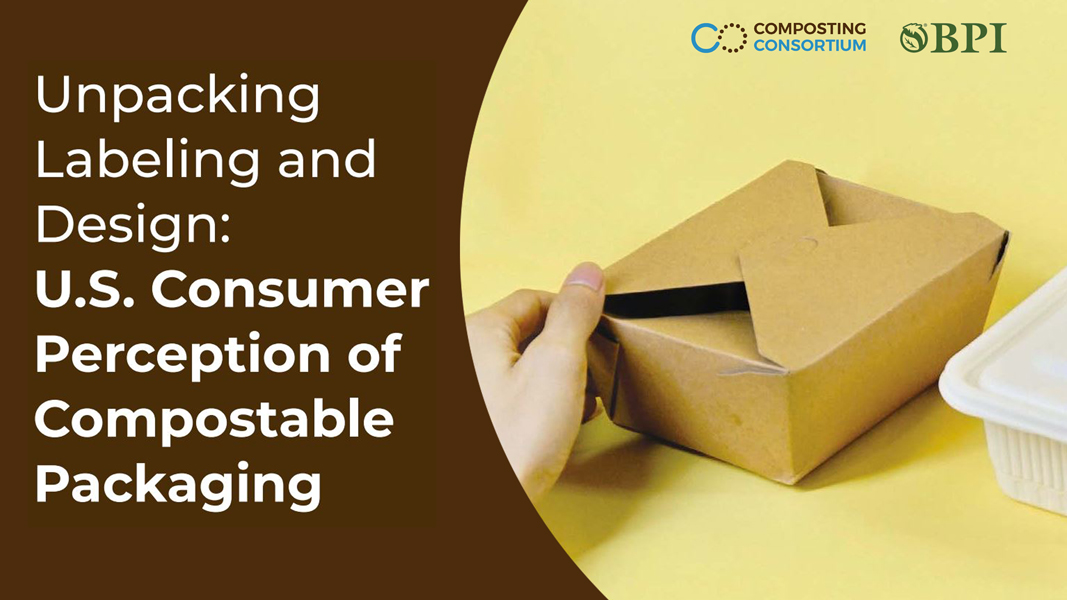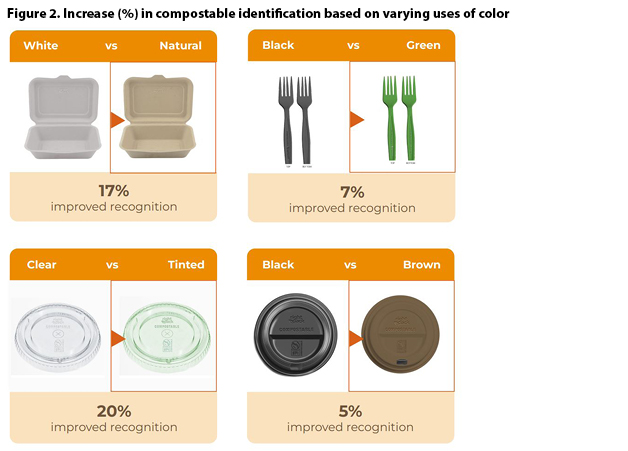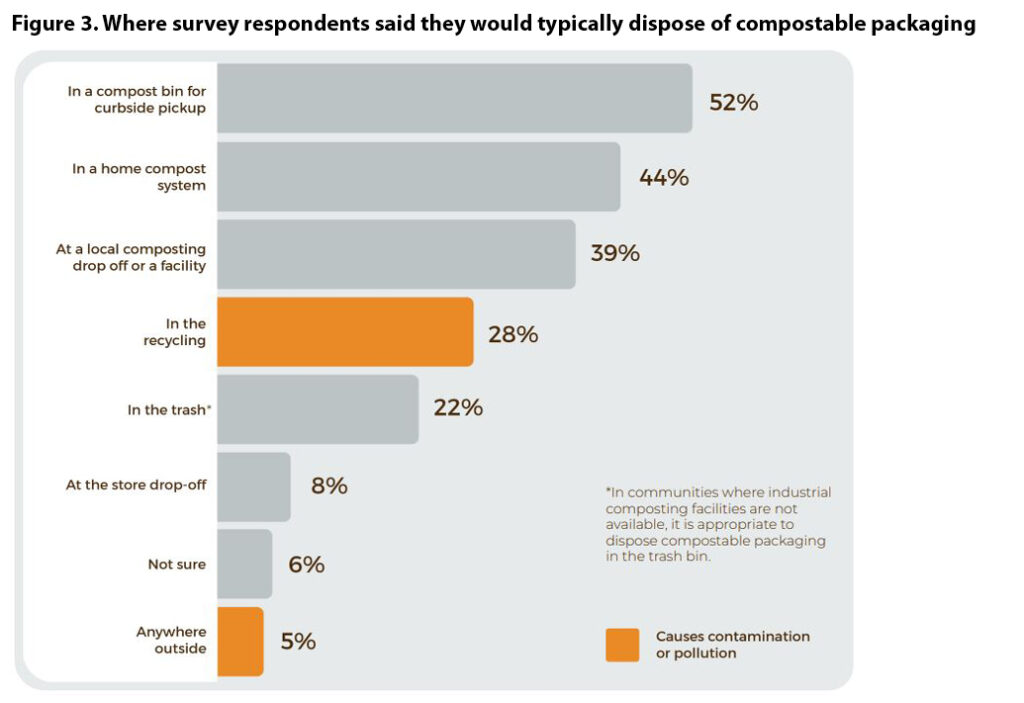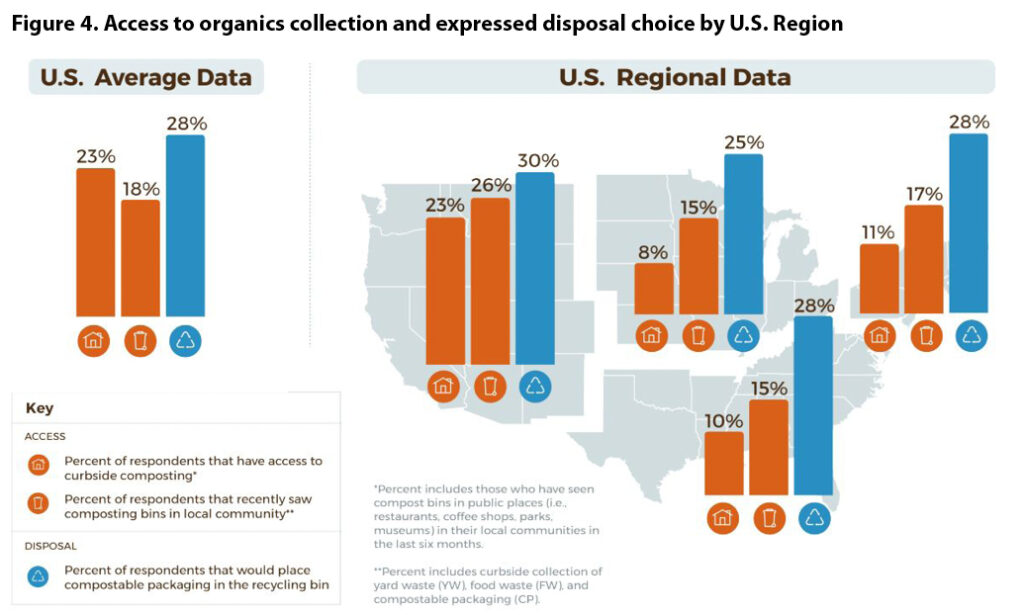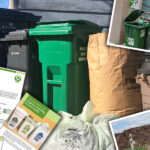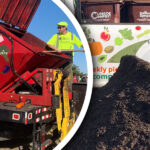Image courtesy of Closed Loop Partners and Biodegradable Products Institute, 2023. “Unpacking Labeling and Design: U.S. Consumer Perception of Compostable Packaging”
Nora Goldstein
The Composting Consortium, an initiative of Closed Loop Partners’ Center for the Circular Economy, teamed up with the Biodegradable Products Institute (BPI) and Bellomy Research to survey 2,765 U.S. respondents in December 2022 to test how different approaches to design and labeling affect how consumers identify, perceive, and dispose of compostable product packaging. The goal was to identify effective design and labeling techniques to improve the diversion of food-contact compostable packaging (primarily foodservice ware) to the appropriate material stream.
The Composting Consortium is a multi-year collaboration across the entire compostable packaging value chain to pilot industry-wide solutions and build a roadmap for investment in technologies and infrastructure that enable the recovery of compostable food packaging and food scraps. The consumer perceptions study was created to fill a critical data gap in the market. “We realized there was an absence of publicly available information on the efficacy of compostable packaging labeling, designs, and techniques,” note Caroline Barry and Paula Luu, lead authors of the Consortium’s report released on July 11, 2023, Unpacking Labeling and Design: US Consumer Perception of Compostable Packaging. “There was also a dearth of data to support assumptions on what types of labels and designs drive confusion among consumers, and what may be leading to improper disposal of these items at the end of their use.”
This article is based on excerpts from the Composting Consortium report.
Methodology
The survey used mixed methods, deploying both qualitative and quantitative questions and an Anchored MaxDiff (otherwise known as Best-Worst) approach that allowed the project team to understand why a respondent rated designs in a specific manner, e.g., “most identifiable” and “least identifiable” option. Barry and Luu, Program Manager and Senior Project Director, respectively, with the Center for the Circular Economy, explain that asking respondents to choose across multiples sets and screens allowed for a clearer differentiation than other common survey approaches, such as ratings scales or “check all that apply”, and allowed them to deduce which products were more or less effective at conveying compostability.
Respondents took the digital survey on desktop and mobile devices. To ensure a representative U.S. sample, quotas were established and weights were applied to balance age, gender, racial identity, ethnic identity, Census region, and household income across the entire pool of respondents.
The survey tested 156 design combinations across 10 compostable packaging product categories and three conventional plastic categories, using the imaginary brand, RightPack, inspired by BPI’s labeling guidelines. A screening question was included at the start of the survey to determine which types of products and packaging the respondent had interacted with over the past three months. With that information, each respondent was assigned to two categories they had used to ensure a level of familiarity.
All labeling techniques tested (e.g., printing, embossing, tinting, and material coloring) are prevalent and in use today. The labeling elements tested are commonly found on compostable and conventional packaging, so respondents were likely to have experienced these elemental designs in their daily lives. Many of these design techniques are referenced in state labeling laws, notes the report.
Seven labeling techniques and elements were tested:
- Large, prominent “compostable” call out vs. small, less noticeable “compostable” callout
- Inclusion vs. absence of striping
- Tinted packaging vs. clear packaging
- Inclusion vs. absence of BPI certification mark
- Printing vs. embossing
- Print color and text (e.g., green vs. brown)
- Package color (e.g., white vs. natural)
Figure 1 compiles the survey respondents’ “winning designs” — packaging designs that received the highest votes — across all 10 packaging categories. (Minimal design depicts the fewest votes.) Across all categories, the “winning design” has at least two to three design elements that communicate compostability. The study found consumer comprehension and correct identification increases when multiple callouts communicate compostability on packages and products. Use of a larger “compostable” callout and the BPI certification mark were the two most important elements in driving the identification of certified compostable packaging. Across all 10 categories, the winning design always included a larger, more prominent “compostable” call out, while 9 out of the 10 included the BPI certification mark.
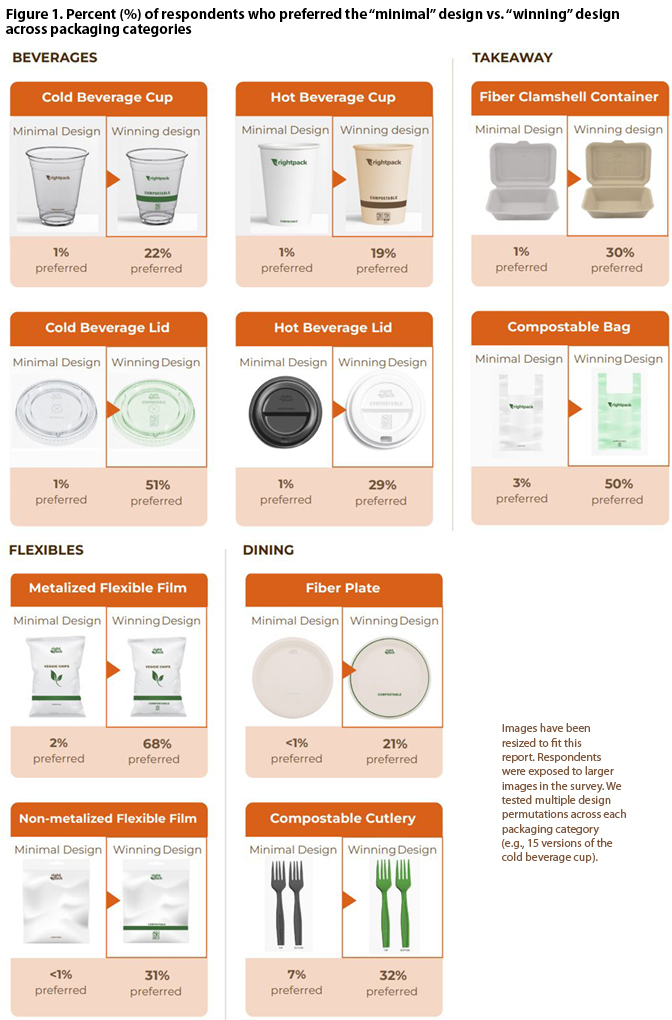
Click to enlarge. All figures reprinted with permission from: Closed Loop Partners and Biodegradable Products Institute, 2023. “Unpacking Labeling and Design: U.S. Consumer Perception of Compostable Packaging”
Figure 2 illustrates the percent increase in compostable identification based on varying uses of color. Across an array of product category, color proved to be an effective indicator of compostability. It can be used through a variety of methods, including inks, base materials, and tinting. Use of natural base materials, brown or green coloring, and green tinting often increased a respondent’s ability to properly identify a product as compostable.
Key Challenges
The report discusses six challenges identified from the survey responses:
The Pervasive Problem With Look-Alikes
Consumers cannot distinguish between packaging labeled “biodegradable” and “compostable.” Four in 10 consumers inaccurately believe biodegradable equals compostable. “While all certified compostable packaging is inherently biodegradable, not all biodegradable packaging is compostable,” emphasize Barry and Luu. “Moreover, biodegradable packaging is not held to the same regulatory standards as certified compostable packaging and is not designed for a controlled composting environment.”
Up to 50% of respondents said they would mistakenly place packaging labeled with “made from plants” in the composting bin. Look-alike products and packaging made of non-compostable plastic materials that are virtually indistinguishable from their compostable counterparts can mislead consumers. Green coloring and tinting, leaf icons and labels such as “made from plants” are often used on both recyclable and compostable packaging. This causes significant confusion among consumers, which can lead to improper disposal of packaging at end of life given “made from plants” does not always mean packaging is compostable.
Contamination Risks
Nearly one-third of respondents said they would incorrectly place compostable packaging in the recycling bin (Figure 3). Consumers are confused about how to dispose of compostable packaging, which is not designed to be recycled and can contaminate the recycling stream if intermixed with conventional recyclable packaging. Cross contamination of recycling and composting with the wrong material is an expensive and pervasive problem.
Limitations of Home Composting
U.S. respondents who compost at home (33%) say they dispose of certified compostable packaging in their backyard bins and piles. The report notes this demonstrates a misunderstanding of certified compostable packaging, which is designed and tested to break down under specific timeframes and microbial conditions at commercial composting facilities — conditions that are often unachievable in backyard bins and piles.
Access to Organics Collection Does Not Equal Understanding
Access to curbside organics collection at home or in public spaces does not appear to improve understanding of where or how to dispose of compostable packaging (Figure 4). Access to curbside organics collection is limited across the U.S. Fewer than one in seven respondents have access to curbside organics collection and only 7% have access to curbside organics collection that accepts compostable packaging specifically. Fewer than one in five respondents have seen separate organics receptacles in public places in their local communities over the last six months. Even in regions like the Western U.S. — where people are nearly twice as likely than the average American to have access to residential curbside organics collection — respondents still mistakenly believed they could place compostable packaging in the recycling bin.
State and Local Policies and Federal Regulations Lack Harmonization
A disjointed approach with local and state level policies and regulations that govern packaging design and labeling creates unnecessary friction and pain points for consumers, brands, and composters. Concerns about contamination in both recycling and composting streams have spurred five U.S. states to enact labeling laws that dictate labeling and design of compostable packaging, including California, Colorado, Maryland, Minnesota, and Washington. “A successful national policy framework requires harmonization across compostable packaging and products, including use of specific colors, design motifs, and qualifying language,” point out Barry and Luu. “Brands curate their products for nations, not states. Labeling policies that differ on a state-by-state basis often make compliance expensive and counter-productive, if not impossible. Policymakers making recommendations on how to design compostable packaging who consult with those who work upstream (brands) and downstream (composters) can develop a harmonized approach to labeling compostable packaging.”
Key Solutions
Unpacking Labeling and Design: US Consumer Perception of Compostable Packaging offers practical solutions to address the challenges identified. Key is to reconcile confusing terms used on packaging, including but not limited to “biodegradable” and “made from plants.” Across the supply chain, adoption of proper labeling and design can facilitate quick and easy identification, increasing the ability for consumers to properly identify a product or packaging as compostable — meaning they are far more likely to dispose of it correctly after use. Achieving industry consensus and adopting consistent labeling practices also can mitigate contamination challenges and enhance the overall value of compostable packaging. “It is essential to hold ‘biodegradable’ claims to a standard that is equal to certified compostable so that these materials do not pose a risk in composting streams,” note Barry and Luu.
Other key solutions based on the survey findings include:
- Visual guides are important. Add a trusted certification logo and prominent “compostable” call out to increase consumers’ ability to identify a package as compostable. Survey respondents best understood and preferred packaging that used two to three design elements (e.g., coloring, text size, etc.) to call out compostability.
- Educate the U.S. population on what packaging should be placed in the recycling bin and industrial organics bin to ensure the success of clean material streams in both recovery systems. Irrespective of age, ethnicity, socioeconomic status, gender, or where one resides, the survey found a significant portion of consumers do not understand what to do with compostable packaging after use.
- Municipalities and local governments with zero waste targets can help bridge this comprehension gap by partnering with brands on educational campaigns to encourage new social norms and sustainable behavior. Leveraging their products as a platform for education, brands have an important role to play in helping advance these goals by educating consumers and streamlining messaging across city and state lines.
- Create a home composting certification standard to help distinguish items that have been specifically designed and tested for home composting bins and piles. As the market is flooded with new technologies and packaging that claim to be home compostable, educating consumers about the do’s and don’ts of home composting becomes increasingly important to prevent contamination risks.
- Harmonize the policies, regulations, and design of compostable packaging nationally, so it works for brands across several sectors and packaging of all shapes and sizes. State laws need to be backed by data to support such propositions; otherwise, these regulations may be perceived as restrictive and unnecessary. To create productive legislation, policymakers, brands, manufacturers, converters, and composters need to work together to share both insights and pain points.
The bottom line, conclude Barry and Luu: “Consumer understanding is just one piece of an enormous and complex puzzle on the road to a circular economy. Brands, retailers, and policymakers must align on standardized design, harmonized labeling regulations, and concerted consumer education to achieve a circular economy for both compostable and non-compostable products and packaging.”


